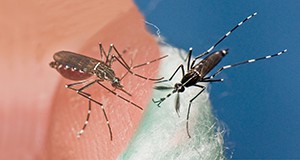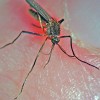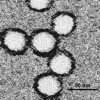
Zika es un virus transmitido por mosquitos que se ha esparcido recientemente en regiones tropicales y ha causado epidemias, especialmente durante los últimos 8 o 9 años. En su ámbito nativo en África Occidental y Uganda, el virus se mantiene en los bosques, circulando entre mosquitos que viven en huecos de árboles y primates arbóreos; las infecciones de humanos se consideran incidentales y de poca importancia médica. Una cepa del virus que se implicó en brotes en Polinesia Francesa emergió en el Norte de Brasil en el 2015 y causó gran consternación debido a la alta incidencia de microcefalia en bebes nacidos de madres que fueron infectadas con el virus durante la gestación. Transmisión local, principalmente por el mosquito de la fiebre amarilla Aedes aegypti, ha sido documentada en la mayoría de los países tropicales de las Américas, pero aún no se ha detectado en Los Estados Unidos Continentales. Los síntomas de la infección incluyen, salpullido, dolor de cabeza, fiebre, dolor muscular y en las coyunturas, conjuntivitis, y malestar general.
This 7-page fact sheet written by J. R. Rey, L. P. Lounibos, B. W. Alto, N. D. Burkett-Cadena, C. C. Lord, C. T. Smartt, and C. R. Connelly and published by the Department of Entomology and Nematology is the Spanish language version of Zika, a Mosquito-Transmitted Virus and describes the Zika microbe, its mosquito hosts, and the disease it causes. A history of the virus and its migration are included, along with some details about the virus in the state of Florida and preventative measures people can take to avoid infection. The best way to avoid contracting Zika (and other mosquito-borne diseases) is not to get bitten in the first place. Take precautions to avoid mosquito bites.
http://edis.ifas.ufl.edu/in1121
Tag: Florida Medical Entomology Lab
Integrated Pest Management for Mosquito Reduction around Homes and Neighborhoods
 This 40-page publication describes how homeowners can use an integrated pest management (IPM) program to help decrease pesticide use, reduce the risk of contracting mosquito-borne diseases, and ease the financial burden on local governments responsible for area-wide control. Modern mosquito control emphasizes source reduction to eliminate areas where mosquitoes thrive; surveillance to determine whether pesticide applications are necessary; screening; sanitation; and other techniques described in this document. The methods recommended in this publication are particularly effective in reducing mosquitoes that transmit diseases. Homeowners who take responsibility for identifying and eliminating sources of mosquito production around their homes and neighborhoods will improve health and quality of life for all Florida residents. Written by C. R. Connelly, E. Bolles, D. Culbert, J. DeValerio, M. Donahoe, K. Gabel, R. Jordi, J. McLaughlin, A. S. Neal, S. Scalera, E. Toro, and J. Walter, and published by the UF Department of Entomology and Nematology, September 2014.
This 40-page publication describes how homeowners can use an integrated pest management (IPM) program to help decrease pesticide use, reduce the risk of contracting mosquito-borne diseases, and ease the financial burden on local governments responsible for area-wide control. Modern mosquito control emphasizes source reduction to eliminate areas where mosquitoes thrive; surveillance to determine whether pesticide applications are necessary; screening; sanitation; and other techniques described in this document. The methods recommended in this publication are particularly effective in reducing mosquitoes that transmit diseases. Homeowners who take responsibility for identifying and eliminating sources of mosquito production around their homes and neighborhoods will improve health and quality of life for all Florida residents. Written by C. R. Connelly, E. Bolles, D. Culbert, J. DeValerio, M. Donahoe, K. Gabel, R. Jordi, J. McLaughlin, A. S. Neal, S. Scalera, E. Toro, and J. Walter, and published by the UF Department of Entomology and Nematology, September 2014.
http://edis.ifas.ufl.edu/in1045
Black-tailed Mosquito Culiseta melanura (Coquillett) (Insecta: Diptera: Culicidae) (EENY536/IN950)
 The black-tailed mosquito is unusual because it overwinters as larvae while most mosquito species overwinter as either adults or eggs. Culiseta melanura is important because of its role in the transmission cycle of eastern equine encephalitis virus and potentially West Nile virus: because adult female Culiseta melanura primarily take their blood meals from birds, they are responsible for transmitting eastern equine encephalitis virus between birds. This 6-page fact sheet was written by Eva Buckner, Angelique Showman, and C. Roxanne Connelly, and published by the UF Department of Entomology and Nematology, September 2012.
The black-tailed mosquito is unusual because it overwinters as larvae while most mosquito species overwinter as either adults or eggs. Culiseta melanura is important because of its role in the transmission cycle of eastern equine encephalitis virus and potentially West Nile virus: because adult female Culiseta melanura primarily take their blood meals from birds, they are responsible for transmitting eastern equine encephalitis virus between birds. This 6-page fact sheet was written by Eva Buckner, Angelique Showman, and C. Roxanne Connelly, and published by the UF Department of Entomology and Nematology, September 2012.
http://edis.ifas.ufl.edu/in950
El Virus del Nilo Occidental (ENY6425/IN185)
 El virus del Nilo Occidental es acarreado por mosquitos y si es transmitido a humanos puede causar una encefalitis severa. Esta relacionado estrechamente con el virus de la encefalitis de St. Louis que a veces es un problema en Florida. El virus del Nilo Occidental fué documentado por primera vez en los Estados Unidos en la ciudad de New York durante una epidemia en 1999. This 4-page fact sheet was written by Jorge Rey, C. Roxanne Connelly, Jonathan F. Day, y Walter J. Tabachnick, and published by the UF Department of Entomology and Nematology, June 2012.
El virus del Nilo Occidental es acarreado por mosquitos y si es transmitido a humanos puede causar una encefalitis severa. Esta relacionado estrechamente con el virus de la encefalitis de St. Louis que a veces es un problema en Florida. El virus del Nilo Occidental fué documentado por primera vez en los Estados Unidos en la ciudad de New York durante una epidemia en 1999. This 4-page fact sheet was written by Jorge Rey, C. Roxanne Connelly, Jonathan F. Day, y Walter J. Tabachnick, and published by the UF Department of Entomology and Nematology, June 2012.
http://edis.ifas.ufl.edu/in185
Embalses Costeros Para el Control de los Mosquitos (ENY648S/IN193)
 Los embalses costeros utilizados en Florida para el control de los mosquitos son marismas o manglares con un dique periférico que permite inundar el área durante la temporada de cría de mosquitos. Desde entonces, investigaciones científicas han demostrado que el embalsamiento puede causar serios impactos ambientales en las marismas, manglares y esteros colindantes. Hoy en día, se ha devuelto una hidrología más natural a más de 1,300 ha de marismas y manglares embalsados y se han eliminado más de 70 km de diques. De las 16,185 ha originales de marismas embalsadas en la laguna Indian River, se han restaurado de alguna manera más de 12,600 ha, ya sea por reconexión, brechas en los diques, o restauración de las orillas. This 6-page fact sheet was written by Jorge R. Rey y C. Roxanne Connelly, and published by the UF Department of Entomology and Nematology, June 2012.
Los embalses costeros utilizados en Florida para el control de los mosquitos son marismas o manglares con un dique periférico que permite inundar el área durante la temporada de cría de mosquitos. Desde entonces, investigaciones científicas han demostrado que el embalsamiento puede causar serios impactos ambientales en las marismas, manglares y esteros colindantes. Hoy en día, se ha devuelto una hidrología más natural a más de 1,300 ha de marismas y manglares embalsados y se han eliminado más de 70 km de diques. De las 16,185 ha originales de marismas embalsadas en la laguna Indian River, se han restaurado de alguna manera más de 12,600 ha, ya sea por reconexión, brechas en los diques, o restauración de las orillas. This 6-page fact sheet was written by Jorge R. Rey y C. Roxanne Connelly, and published by the UF Department of Entomology and Nematology, June 2012.
http://edis.ifas.ufl.edu/in193
Mosquito Control Impoundments (ENY648S/IN192)
 A mosquito control impoundment is a salt marsh or mangrove forest with an earthen dike around the perimeter that allows the area to be artificially flooded during the mosquito breeding season. Since the seventies, research has shown that impounding can have severe environmental impacts on the marshes and the adjoining estuary. So, over 12,600 hectares of the original 16,185 of impoundments have been rehabilitated in some fashion. This 6-page fact sheet was written by Jorge R. Rey and C. Roxanne Connelly, and published by the UF Department of Entomology and Nematology, June 2012.
A mosquito control impoundment is a salt marsh or mangrove forest with an earthen dike around the perimeter that allows the area to be artificially flooded during the mosquito breeding season. Since the seventies, research has shown that impounding can have severe environmental impacts on the marshes and the adjoining estuary. So, over 12,600 hectares of the original 16,185 of impoundments have been rehabilitated in some fashion. This 6-page fact sheet was written by Jorge R. Rey and C. Roxanne Connelly, and published by the UF Department of Entomology and Nematology, June 2012.
http://edis.ifas.ufl.edu/in192
Ehrlichia y Anaplasma en Florida (ENY662S/IN422)
 Ehrlichia y Anaplasma son géneros bacterianos emparentados que causan enfermedades en humanos y en animales domésticos. A las enfermedades se les llama generalmente erliquiosis (ehrlichiosis) o anaplasmosis, pero existen varias especies de bacteria que causan diferentes síntomas y pueden tener diferentes vectores. This 4-page fact sheet was written by Jorge R. Rey, Cynthia C. Lord, y Roxanne Rutledge Connelly, and published by the UF Department of Entomology and Nematology, July 2012.
Ehrlichia y Anaplasma son géneros bacterianos emparentados que causan enfermedades en humanos y en animales domésticos. A las enfermedades se les llama generalmente erliquiosis (ehrlichiosis) o anaplasmosis, pero existen varias especies de bacteria que causan diferentes síntomas y pueden tener diferentes vectores. This 4-page fact sheet was written by Jorge R. Rey, Cynthia C. Lord, y Roxanne Rutledge Connelly, and published by the UF Department of Entomology and Nematology, July 2012.
http://edis.ifas.ufl.edu/in422
El Mosquito Culex Iolambdis (ENY727S/IN901)
Culex (melanoconion) iolambdis es un mosquito pequeño de color marrón oscuro que existe en sitios tropicales y subtropicales. En los Estados Unidos, solo se encuentra en el sur de Florida. Se conoce poco sobre la biología y comportamiento de este mosquito. El subgenéro Melanoconion se distingue por el pequeño tamaño de sus especies y por dificultad en diferenciar las diferentes especies. This 4-page fact sheet was written by Jorge R. Rey, Erik M. Blosser, Stephanie K. Larrick and C. Roxanne Connelly, and published by the UF Department of Entomology and Nematology, September 2011.
http://edis.ifas.ufl.edu/in901
Red-tailed Flesh Fly, Sarcophaga haemorrhoidalis (Fallén) (Insecta: Diptera: Sarcophagidae) (EENY495/IN896)
 Another insect important to forensic investigations, red-tailed flesh fly larvae invade carcasses that are in the early to advanced stages of decomposition, often arriving as early as blow flies. Learn more in this 4-page fact sheet written by Angelique Showman and C. Roxanne Connelly and published by the UF Department of Entomology and Nematology, August 2011.
Another insect important to forensic investigations, red-tailed flesh fly larvae invade carcasses that are in the early to advanced stages of decomposition, often arriving as early as blow flies. Learn more in this 4-page fact sheet written by Angelique Showman and C. Roxanne Connelly and published by the UF Department of Entomology and Nematology, August 2011.
http://edis.ifas.ufl.edu/in896
The Mosquito (ENY727/IN652)

It’s the height of mosquito season, are they getting under your skin? Mosquitoes are some of the most versatile organisms on earth. They can reproduce in virtually any natural or man-made deposit of water, and have been found in mines deep below the surface, in mountain peaks, in highly polluted water bodies, in snow pools, and even in crab holes. They occur throughout the globe and can survive in most of earth’s climates. Although they can be annoying and some are serious health threats, they can play an important role in natural communities, particularly as filter feeders in aquatic communities, and as a food source in both aquatic and terrestrial food chains. Learn more in this 7-page fact sheet by Jorge R. Rey, published by the UF/IFAS Department of Entomology and Nematology, June 2010.
http://edis.ifas.ufl.edu/in652
AN240 Florida Cracker Cattle
AN240, a 4-page illustrated fact sheet by Jorge R. Rey, describes this small to moderately-sized breed of cattle descended from the original cattle brought to Florida by the Spanish in the 1500s — history, breed characteristics, beef, organizations, and contacts. Published by the UF Department of Animal Sciences, May 2010.
http://edis.ifas.ufl.edu/an240
EENY457/IN837 Southern House Mosquito Culex quinquefasciatus Say
EENY457, a 6-page illustrated fact sheet by Stephanie Larrick and Roxanne Connelly, is part of the Featured Creatures collection. It describes this medium-sized brown mosquito that exists throughout the tropics and the lower latitudes of temperate regions and is a vector of many pathogens, several of which affect humans — synonymy, distribution, description, life cycle, medical importance, and management. Includes references. Published by the UF Department of Entomology and Nematology, November 2009.
http://edis.ifas.ufl.edu/IN837
ENY744S/IN832 El Laboratorio de Entomología Médica de Florida
ENY744S, a 6-page illustrated fact sheet by Jorge R. Rey, C. Roxanne Connelly, and Chelsea T. Smartt, is the Spanish language version of ENY-744/IN772: The Florida Medical Entomology Laboratory. It describes this UF/IFAS facility located in Vero Beach FL, and its research, education, and teaching programs. Published by the UF Department of Entomology and Nematology, November 2009.
http://edis.ifas.ufl.edu/IN832
ENY855/IN811 The Female Mosquito’s Quest for Blood: Implications for Disease Cycles
ENY855, a 4-page illustrated fact sheet by Stephanie L. Richards, Sheri L. Anderson, and Chelsea T. Smartt, tells the story of the female mosquito’s quest for blood and how it may affect our lives. It tells why only female mosquitos feed on blood, what makes a blood source suitable, why some people are more attractive than others, and why host preference is important for understanding endemic and emerging arthropod-borne disease cycle. Published by the UF Department of Entomology and Nematology, October 2009.
http://edis.ifas.ufl.edu/IN811
AN219 El Caballo Cracker de Florida
AN219, a 5-page illustrated fact sheet by Jorge Rey, is the Spanish language version of AN216: The Florida Cracker Horse. It describes this small breed of saddle horse designated “Florida’s Heritage Horse” by the Florida Legislature in 2008 — breed characteristics, history, current status, and events. Includes references. Published by the UF Department of Animal Sciences, June 2009.
http://edis.ifas.ufl.edu/AN219
AN216 The Florida Cracker Horse
AN216, a 4-page illustrated fact sheet by Jorge Rey, describes this small breed of saddle horse designated “Florida’s Heritage Horse” by the Florida Legislature in 2008 — breed characteristics, history, current status, and events. Includes references. Published by the UF Department of Animal Sciences, March 2009.
http://edis.ifas.ufl.edu/AN216
EENY491/IN791 Common malaria Mosquito Anopheles quadrimaculatus Say (Insecta: Diptera: Culicidea)
EENY-491, a 6-page illustrated fact sheet by Leslie M. Rios and C. Roxanne Connelly, describes this historically most important vector of malaria in the eastern United States — synonymy, distribution, description, life cycle, medical significance, surveillance and management. Includes selected references. Published by the UF Department of Entomology and Nematology, February 2009.
http://edis.ifas.ufl.edu/IN791
ENY744/IN772 The Florida Medical Entomology Laboratory
ENY-774, a 7-page illustrated fact sheet by Jorge R. Rey, C. Roxanne Connelly, and Chelsea T. Smartt, describes this UF/IFAS facility located in Vero Beach FL, and its research, education, and teaching programs. Published by the UF Department of Entomology and Nematology, July 2008.
http://edis.ifas.ufl.edu/IN772
EENY 440/IN775 Human Bot Fly, torsalo (Central America), moyocuuil (Mexico), berne (Brasil), mucha (Columbia, mirunta (peru), and ura (Argentina, Paraguay, and Uruguay), Dermatobia hominis (Linnaeus, Jr.) (Insecta: Diptera: Oestridae)
EENY-440, a 6-page ilustrated fact sheet by Stephanie Larrick and Roxanne Connelly, is part of the Featured Creatures Collection. It describes this large, densely haired fly native to Central and South America, which, in its larval stage, infests the skin of mammals causing painful pustules, a condition known as myiasis. Includes references. Published by the UF Department of Entomology and Nematology, September 2008.
http://edis.ifas.ufl.edu/IN775
ENY-743S/IN769 Lengua Azul
ENY-743S, a 5-page illustrated fact sheet by Jorge R. Rey, Walter J. Tabachnick, Chelsea T. Smartt, and C. Roxanne Connelly, is the Spanish language version of ENY-743/IN768 Bluetongue. It answers common questions about this viral disease of ruminant livestock transmitted by biting midges, the virus, clinical signs of bluetongue, economic impact, transmission, diagnosis, cure, distribution, presence in Florida, and prevention. Includes references. Published by the UF Department of Entomology and Nematology, June 2008.
http://edis.ifas.ufl.edu/IN769